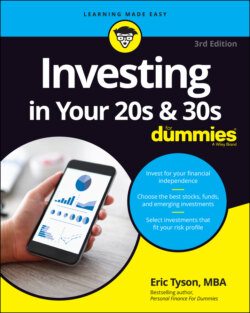Читать книгу Investing in Your 20s & 30s For Dummies - Eric Tyson - Страница 22
Making sense of returns
ОглавлениеEach investment has its own mix of associated risks that you take when you part with your investment dollar and, likewise, offers a different potential rate of return. When you make investments, you have the potential to make money in a variety of ways.
To determine how much money you’ve made or lost on your investment, you calculate the total return. To come up with this figure, you determine how much money you originally invested and then factor in the other components, such as interest, dividends, and appreciation or depreciation.
If you’ve ever had money in a bank account that pays interest, you know that the bank pays you a small amount of interest in exchange for your allowing the bank to keep your money. The bank then turns around and lends your money to some other person or organization at a much higher rate of interest. The rate of interest is also known as the yield. So if a bank tells you that its savings account pays 1.5 percent interest, the bank may also say that the account yields 1.5 percent. Banks usually quote interest rates or yields on an annual basis. Interest that you receive is one component of the return you receive on your investment.
If a bank pays monthly interest, the bank also likely quotes a compounded effective annual yield. After the first month’s interest is credited to your account, that interest starts earning interest as well. So the bank may say that the account pays 1.5 percent, which compounds to an effective annual yield of 1.53 percent.
When you lend your money directly to a company — which is what you do when you invest in a bond that a corporation issues — you also receive interest. Bonds, as well as stocks (which are shares of ownership in a company), fluctuate in market value after they’re issued.
When you invest in a company’s stock, you hope that the stock increases (appreciates) in value. Of course, a stock can also decline, or depreciate, in value. This change in market value is part of your return from a stock or bond investment.
Stocks can also pay dividends, which are the company’s way of sharing some of its profits with you as a stockholder and thus are part of your return. Some companies, particularly those that are small or growing rapidly, choose to reinvest all their profits back into the company.
Unless you held your investments in a tax-sheltered retirement account, you owe taxes on your return. Specifically, the dividends and investment appreciation that you realize upon selling are taxed, although often at relatively low rates. The tax rates on so-called long-term capital gains and stock dividends are currently and historically lower than the tax rates on other income. I discuss the different tax rates that affect your investments and explain how to make tax-wise investment decisions that fit with your overall personal financial situation and goals in Chapter 4.
